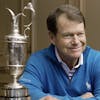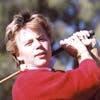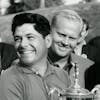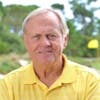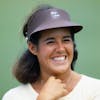Jane Blalock - Part 4 (The Later Wins, Legends and Legacy)

In the finale of our four-part series with golf icon Jane Blalock, "FORE the Good of the Game" delivers an episode teeming with wisdom, resilience, and trailblazing spirit. As one of the most formidable figures in women's golf, Jane brings to life the culmination of her groundbreaking journey, painting an intimate portrait of her professional and personal milestones.
In this episode, Jane digs deep into the indelible moments that have defined her legacy, from her unprecedented 27 LPGA Tour victories to the controversies and triumphs that shaped her illustrious career. Amid stories of grace under pressure and challenging the status quo, Jane also opens up about the essence of leadership and how her business, JB Sports, is playing a pivotal role in the present and future of golf.
But the conversation doesn't stop at the fairways and greens. Jane reflects on her role as a pioneering woman in a sport often dominated by men, sharing insights that are pertinent not just for the golfing community but for anyone who seeks to break barriers and lead with authenticity. She also discusses her charitable endeavors, emphasizing the transformative power of sport in enriching lives and fostering community.
Our host, Mike Gonzalez, and co-host, Bruce Devlin, navigate this riveting dialogue with Jane, unearthing nuggets of wisdom that make this episode a must-listen for golf enthusiasts and aspiring leaders alike. As part of a series that has already dived into Jane's early years, competitive ethos, and challenges, this final installment is the perfect capstone, embodying the core tenets of our podcast—preserving the richness of golf history, told by the people who made it.
Don't miss out on this remarkable conclusion to our time with Jane Blalock, an episode destined to be a staple in our archive that even the USGA is keen to preserve for generations to come. Hit that 'Follow' button to ensure you never miss the rich tapestry of stories we're here to share, "FORE the Good of the Game!"
Follow our show and/or leave a review/rating on:
Our Website https://www.forethegoodofthegame.com/reviews/new/
Apple Podcasts https://podcasts.apple.com/us/podcast/fore-the-good-of-the-game/id1562581853
Spotify Podcasts https://open.spotify.com/show/0XSuVGjwQg6bm78COkIhZO?si=b4c9d47ea8b24b2d
Google Podcasts https://podcasts.google.com/feed/aHR0cHM6Ly9mZWVkcy5idXp6c3Byb3V0LmNvbS8xNzM3Mjc1LnJzcw
About
"FORE the Good of the Game” is a golf podcast featuring interviews with World Golf Hall of Fame members, winners of major championships and other people of influence in and around the game of golf. Highlighting the positive aspects of the game, we aim to create and provide an engaging and timeless repository of content that listeners can enjoy now and forever. Co-hosted by PGA Tour star Bruce Devlin, our podcast focuses on telling their life stories, in their voices. Join Bruce and Mike Gonzalez “FORE the Good of the Game.”
Thanks so much for listening!
Music playing 00:00
Mike Gonzalez 00:15
So we're coming out of the we're coming out of the 70's now Jane and of course, you know if you look at the typical career not not everybody but it's sort of shaped like a bell curve right in terms of your your wins and your successes and your money winnings everything else. So you're probably on the you're gonna approach the downward slope now as you come off of this sensational run where you're winning four or five times a year. You win a couple of times in 1980. You win the Elizabeth Arden, down in Florida over Jerilyn Britz and Debbie Massey, and then the Inamori classic. I'm sorry, I should say the Inamori Classic is in 1980, where that made streak, cut streak ends. I probably misspoke when I mentioned Ericsson, he would have been in place back when you started in 69, perhaps in 1980. Probably a different Commissioner who I can't remember if it would have been Ray Volpe from 75 to 82. I thought he was
Blalock, Jane 01:08
I think it was John Laupheimer.
Mike Gonzalez 01:10
Okay, I'll take your word for it,
Blalock, Jane 01:11
I think.
Mike Gonzalez 01:12
Yeah. Okay. All right. All right. I'll take your word for it. Anyway. So what's happening your mind your body, your life? How you feeling about your game? Are you realizing at this point that, you know, what we've got these youngsters coming on, on and man they are using this new equipment and they're hitting it long.
Blalock, Jane 01:31
Yeah, they had hybrids? Well, it was a combination of things. So started out, you know, winning the Elizabeth Arden again, just played really well. But then my back started acting up on me a little bit. And I didn't stop playing, but I made some compensations. In my, in my golf swing, which didn't pay off. So I gradually just felt like, you know, I, I felt I'll let's finish top 10 Instead of thinking about winning, and then it was let's finish top 20. And just, the game just wasn't quite as good. I mean, I, you know, I made the cuts up until, you know, the very end, but I just kind of felt and then once the game starts to go, you know, it does things with your mind, you start to lose that sense of confidence. And it wasn't as much fun going to the Golf Course, it was just some of the passion, the excitement had deteriorated, let's say not diminished is probably the better word. And so now we get to the end of the year, you know, the faithful antibody classic. And then that doesn't obviously doesn't go well. And saw they kind of just kind of go shoo, you know, Yeah, kinda lose some steam, lose, lose some energy. And then it's okay, I, you know, do I want to evaluate, you know, where I am. And it just, all of a sudden, it wasn't as much fun and I had promised myself, if I, if there's a period of time where I cannot give 100%, then do something else. And you don't belong there because of so much respect for the game. And I always end, you know, for the fans, and I always want to give it my you know, my very best and you can't do that with in a half hearted way.
Mike Gonzalez 03:43
Well, and that, that explains well, sort of the dry spell, if you will, from 80 to 85, in terms of victories anyway, but, you know, the the, the tour was still evolving. Just another example for our listeners, purses in 1980 I mentioned earlier before a little over $5 million coming out of that decade when The Dinah Shore was introduced, and Colgate Palmolive was involved in the tour. By 1990, 10 years later, purses grew to about $17 million. So things were still happening to the positive in terms of the tour development, one of the things that that you and several ladies perhaps didn't agree with, was in 1991, how the tour was being marketed. And, you know, they chose, they made a conscious decision to to use sex appeal to attract viewers, attract followers and so forth. And, you know, right or wrong. I think your point and the point of others was, wait a minute, we've got a lot of talent on this tour, we should be showcasing Is this the way to do it. Now. Most of your opinions were expressed privately or perhaps to to friends and so forth. But you decided to put your views down. You talked about writing and, and so forth well you wrote them down, didn't you?
Blalock, Jane 05:01
Yeah, must have been that second glass of wine. Well, it was mentioned writing. So, a friend of mine was a Miami Herald said I'd like you to do a column, you know, just write a column on something with the LPGA women's golf. And I just received we had the LPGA publication with called fairway magazine. And I had opened it up and saw this photoshoot. And it was it was Muffin Spencer Devlin, Janet Cole's, Jan Stephenson, there was one other player that I don't recall. But they were photographed in very, very suggestive situations, like one was laying on an unmade bed, you know, partially sheets covering most of her. They were, it wasn't, I mean, I was all in favor, sex appeal, whatever you can, you know, sell tickets, and let's get people out there. But I think in my article I remembered now I called it quasi pornography. And I thought, wow, this is just a little over the top. It's not showing someone a great with a great body and a short skirt and someone that's worked out. It was very, very suggestive and it wasn't sex appeal, it was more like sex. So I just felt it was not appropriate. And my article stated something the effect that the LPGA has so much talent, and at a time and I think I mentioned Billie Jean King's in there when women athletes are starting to be respected, but they are doing as opposed to what they look like. Yeah. Then this is a little inconsistent, off kilter. And so I called out the LPGA. But the the unfortunate thing is, because Jan Stephenson and I are great friends today. We always were good friends, I so much respect for her work ethic and her ability to play. But they took Jan's picture and attach it to the article. So now it looked like it was an attack on Jan Stephenson. So we had a few words. And then oh, boy did that. And then. So there's a Miami Herald, Well, lo and behold, it hit the AP. So now Associated, now it's an every newspaper in the country. So now I'm the now I'm like, the the evil, the bad, who the bad guy. And here's poor Jan, the innocent victim, but it was, and when they, some of the article was reprinted, that was totally out of context. So they, as I'm sure this never happened, either one of you?
Devlin, Bruce 07:44
No, no, It's never happend. No.
Blalock, Jane 07:46
And so Jan and I had some long talks after that. And they wanted, you know, they wanted to really pit us. They were trying to create this great rivalry, this hype, and I decided not to feel that I've had enough in my life. Yeah. And so I refuse some of the talk shows. I said, No, no this is private. But it was much more of the LPGs marketing initiative, that nothing to do with with Jan.
Mike Gonzalez 08:15
Right? Yeah, it was very real. And I think they probably in retrospect, felt they got the results out of that. But as you say, when when you talk to Jan Stephenson, which we did about this particular time in her life, if she had it to do over again, as I mentioned before, she wouldn't do it. She felt it detracted from her record, as a player and as you know, as you mentioned, as hard to work are probably out on that tour is anybody and so, you know, if if you're listening to this, and you're old enough, you remember this time and you remember some of the posters that were up on the little boys walls and things. But what people sometimes unfortunately take away from that is Jan Stephenson pinup girl, much like some of the others of that era, but but here's a woman that won 27 times professionally 16 times on the tour and won three majors. So she was a player with a great record in the Hall of Fame. And yet sometimes what people remember her for or not her, not her playing capabilities. Yeah,
Blalock, Jane 09:17
no, I agree. And that that frustrates me as well because she is such a great player and we know she's going through a challenging time right now. But she, one of the tournaments I run is the team championship and I was paired with Jan a couple of years ago and she and her partner Laura Diaz won the tournament. And boy Jan, she hasn't lost a bit of that competitive fight. She was great. And I will say, you know, it was more that the LPGA, Jan whatever she wants to do promoting yourself was fine. You know, the golf balls in the bathtub. But when the LPGA is doing that, that's what I took exception with.
Mike Gonzalez 09:59
Yeah, yeah. Well you came out of this stretch I mentioned from from 80 to 85. You came out of that and you still had a couple of wins in you, didn't you?,
Blalock, Jane 10:06
Yeah. Well, I took I took time off. I went back to New Hampshire, I rented a house, actually right on the ocean, in New Castle, New Hampshire, Wentworth by the Sea. And I just want to just to think, I read books, I just did other things, you know, got to, you know, kind of get back with my family, again, not that I was separated. But you know, I've been a little life and travel. And I just kind of just wanted to call it and just make decisions. I don't want to make any quick decisions about my future. I just want her to allow it to come to me. And, and it did. So it was after about a year and a half. I said, you know, something? I'm not done. I'm not old. I hadn't turned 40 yet. I said, I think I might have a little fight in me. So I changed my hairstyle. I changed my golf equipment. I went to Ed Oldfield for instruction. He had worked with Betsy King very successfully. And I said, let's try it. Let's do something totally different. So I, I shouldn't say recommitted, because I've never not been committed. But I said, Let's just, let's just work on let's see what happens. Well, at the end of toward the end of 84, I had some, I felt things happening, I felt my ball striking was different, and I had some top 10 finishes. And you know, that's all it takes. So I had gone from, you know, let's, you know, this top 10, top 20 Let's make the cut. And then the time off, and then I kind of felt oh, something's coming back here. And I felt that the kind of the competitive juices were flowing freely again. But more importantly, my ball striking was good. So I continued to work on it through the winter of 84 and came out in 85. And just had a great year and just hit it well, again, excellent ball striking. My putting never left me. So I had that and you know, the biggest 85 So now I hadn't won. Now we go to Hawaii to the Kemper and wind is that it was 30, 40 mile an hour gusts that you couldn't, couldn't stand up. We're at Kaanopoli and Pat Bradley and I had separated ourselves from the field. I mean, it was one would just it was a two person horse race. And, you know, going back on my own, you know, when when shots and coming down the stretch and you know, playing with Pat, we get to the last toll, she has a one shot lead and said, I can't tell you how hard the wind is blowing in our face. And she made a mistake. Yeah, she had it left. I tried to hit it too. I said I want to win. So I tried to you had to carry a pond. And so I carried the pond. But then it came back in. So I've still you know, I missed by about a foot of having a perfect shot. So then I had to drop it. And but I got to drop it on the green side because I said it carried it. And Pat had a putt to win. And she left it or to tie. She left a short putt for I can't remember exactly, but all I know is I had about a 7-8 foot putt and left to righter, slow and I rammed it home and right in the hole. So that kind of that was a huge victory. I hadn't won and, you know, few years. So it was very meaningful. And you know, Pat and I are both from the you know, we're friends too. It was really fun beating her in that. Fun to beat your friends. And so that was that was that was huge. But then the best part after I won. And you know, so now we're talking yeah, hadn't won since 1980. So here we are in Hawaii. We're staying at this beautiful Marriott. So I decided and I won $45,000 I was rich. I mean, that was huge, like, but the money didn't mean anything. It was kind of redemption. And so I invited all the caddies, the media of the players. I threw a party it was St. Patrick's Day. by the pool. And about $5,500 later I wrote a check to th Marriott. They had a band playing, I paid the band extra money to stay on to play longer. It was players to this day talk about that party. Oh, that's one of those things you do that it was like, wow, the culmination of, you know, the drought and winning and it was it was so much fun.
Mike Gonzalez 15:30
Well, that was your last win in the U.S. But you still had one win in you later that year, because you went to Japan and won with a final round 64 You wait till your your last win to shoot your career best I guess.
Devlin, Bruce 15:45
Isn't that amazing!
Blalock, Jane 15:47
Well, that was that was a round a golf for the ages. Because I was also trying to qualify, they had the Mazda. It was Champions and LPGA. The top 10 would go to Jamaica, and play a team event. And you're allowed to bring guests so I said I want to bring my family. I want to bring my parents with me. And so I had motivation. And I you know, hit the ball. Well, first couple rounds are and then the first three rounds then the final day. It was a par 73 But it was the finest ball striking day I've ever had in my life will ever have. I hit three and four irons for my second shots. It wasn't one of those courses where you're hitting wedges. It was just extraordinary. I think I missed one green. I made a putt for a bogey which saved me so I actually made 10 made Yeah, 10 birdies. Well and, but I did it with just long irons. And, and then it came down to the I had Lopez in back of me and Iyu Tu who was a great Japanese player and back of me or a player that played the Japanese tour. And I had to make myself suffer I had to make a, you know, five or six footer on the last told to kind of seal the deal. Then I knew but it was a Bruce, you know how and in Japan, it's the ceremony and the pomp and circumstances. I'm sending up the presentation receiving gift after gift which I still have many of them. And you know, did my my few remarks that I learned to Japanese to show my respect. But I'm sitting there presentation and I literally felt a physically felt something come out of me. i It's almost like this is it. I made the comeback. I gave it everything I have. And I think this is a wonderful way to end. It was I remember that feeling to this day. It was just like, like, someone took the handcuffs off, you know permission. And I get that time I gave myself permission to move on to do something else in my life.
Mike Gonzalez 18:05
And move on you did shortly thereafter because you really didn't play full time for very much longer after that. Did you?
Blalock, Jane 18:10
I dabbled in 86. In my mind, I left I had I had honored some commitments. Some courses that were volunteers and the tournament chair had been kind and asked me to play the Dinah just for because I wanted to play that. But I had already kind of one one foot out.
Mike Gonzalez 18:34
Easy decision at that point then?
Blalock, Jane 18:37
Very Yep. Because I had I didn't need to prove anything else. And and then I took right after that I took some time. I guess I'm really good at taking time and thinking. But by leaving now, I have one. Let's see. Then I had still won 29 tournaments. That was still I had won 29 official tournament still with that time. And so you know, with the Hall of Fame criteria, then was specific. And I said okay, do I want to abandon the quest for the Hall of Fame. So that summer I went to spent a couple of weeks on Monhegan Island off the coast of Maine. Again, very generators, just very, you know, nothing fancy just absolutely beautiful kind of an artist's colony. And I just did a lot of walking and in thinking and actually wrote it I put it on paper. I think I still have it four or five pages on you know why I'm leaving and why it's okay to leave and I said okay. By leaving now I am giving up the chance to be in the Hall of Fame and that's okay because I gave the game of golf, everything I had, I couldn't have, you know, for a kid from New Hampshire, I couldn't have gotten any more out of the game than I did. If I was inducted in the Hall of Fame, is that going to change the way I look in the mirror? Is that going to change the way people are that are important to me perceive me? And when I figured out the answer was no. And that it was time for me to move on and do some things I really wanted to do. And that that was okay. So I just I made the decision that it's okay not to continue the quest to go into the Hall of Fame. Because the clock is ticking. And I want to make a difference doing some other things.
Mike Gonzalez 20:50
Yeah. Did you ever publish that or make it available to anybody?
Blalock, Jane 20:54
No, no, I haven't.
Mike Gonzalez 20:57
Interesting
Blalock, Jane 20:58
I'll have to see where I, where I filed it away. Because I reread it a while ago. Wow. That's pretty. That's pretty profound.
Mike Gonzalez 21:08
Yeah. Well, we, Bruce and I would love to make it part of your record in perpetuity along with this story. But anyway, just just
Blalock, Jane 21:18
As long as I didn't slander anyone in there? Yeah. I'll have to take a look.
Mike Gonzalez 21:23
You better re-read it. So before we get to sort of life after golf, I just want to quickly spin through the majors because, you know, I didn't make the point at the top but you stand in the ladies world as the lady that won the most tournaments without a major. And yet when you look through your major record, boy, you are sure there are a lot. You had a lot of chances. And so I'm just going to spin through a few you know, we talked about The Dinah Shore you winning the inaugural but it wasn't a major until 1983. In 85 and 86 by then you were you're fairly deep into your career and so maybe not as high a finish at in the Dinah when it was a major but the LPGA you finished second in 72 at Pleasant Valley. 1980 you were second to Sally Little at the at the Nicklaus Sports Center in Ohio. U.S. Open a third in 71 to Susie and a third to JoAnne Carner in 76 You had a fourth place at the du Maurier. Titleholders probably only one I would guess that you played in that was the last one that was sort of a reprise of a tournament that really ended back in the 60s. But they played it one more time in 72 in Pine Needles, where you were T-seven to Sandra Palmer so and I'm sure there are others that I didn't mention, but But you put yourself in contention a lot.
Blalock, Jane 22:48
Well, during most of my era, we only had two majors. Yeah, we had the LPGA Championship and the Open. And Sally Little tells one of my great friends and am I'm introducing her and we've done some clinics together. I always say she's the one she's kept the ball through the water at the LPGA made on the green and that's why I didn't win my my major LPGA Championship. We always joke about it. I tell her she stole it from me. And you know, that's all in jest. And then the funny story is that that Open when the big mama connection with Sandra and JoAnne Carner. We'd had several rain delays, that final day and I was making a charge. And I can't remember it was a par three, it was I think it was the 15 pole. And pin was on the front of the green and I hit what I thought was a pretty good shot hit the front of the green and then sucked back into the bunker. Again. Now it's wet and the bunker, and I've never known that USGA to do this, but because of the torrential rains, there was a huge washout area. I mean, it was a trench and my ball ended up in that trench and I couldn't make contact with it. So they had you know after the rain, they didn't change anything but somehow it was an oversight. They never fixed it. And I'm not making this up. And then I ended up you know swatting and swatting, and I ended up finally chipping in for a double bogey. Oh my goodness. And I was on a move so I remember that one well, because that's one that I thought I really had a chance to win because I was playing so well. It was just a little bit you know, the shop wasn't perfect to the green. But it wasn't certainly wasn't that bad. But one of those things that just there was no way to make contact with that. So those were my two that I really should have. Susie burning had a pretty good lead at that Winged Foot at that event. But that was they had had a lot of rain then too and got rough rough was at least a foot deep and wet. We used to have to sandwiches to even get out of it. And tomorrow we have another one I always I played with those were very, very fast greens. I always put a well on fast greens, but never. They had presented a a bowl to the person that played the best and all the majors during a year. And I did win that not winning a major. So yeah, I had my I had my chances, but just didn't. I was never great driver of the golf ball. I attended in play, but that was not my my strength. So I think had I been a better driver of the golf ball, I would have had a better chance to, you know, to compete at the opens.
Mike Gonzalez 25:48
Yeah, well, to your point from 1968 to 1978, with the exception of one year. So the for those 11 years, 10 of those years, only two majors, you mentioned what they were. And then in 72, of course, they brought back the title holders just for a one off. I'm not quite sure why they did that why it wasn't sustained. But in the early days, the title hold lose, of course, was I guess even before The Dinah Shore was sort of the Masters for the LPGA Tour. It was Augusta Country Club, right there, one golf course the same year, every year.
Blalock, Jane 26:19
Right. Exactly. Yeah. And it's funny, and it's not I mean, when you look at major records, and now you have five, but again, I'm never one to say poor me, that wasn't meant to, to denote that.
Mike Gonzalez 26:34
Well, one of the big things that came out of your career is as you move on away from golf, but you never really got away from golf. But you were quite instrumental in, in raising the flag for, let's call it the Legends Tour. It's gone by different names, but you are at the forefront of saying, Hey, we've got to do something for these ladies that can still play.
Blalock, Jane 26:56
Yeah, exactly. It was, it was frustrating, you know, we'd always talk in the locker room, and, you know, the guys had their chance to continue competing and make some money, you know, beyond there, you know, the prime prime of life. And, you know, we didn't have it, we didn't have a chance. And so I just, I said to the players, I said, let's stop talking in the locker room, because that's not accomplish anything. Let's see, let's go out there and see what we can do. So, you know, I started talking to the LPGA. And, you know, it was, gosh, ty votaw. And we should have a women's senior tour. And, you know, and again, I saved all that communication. I guess I'm a hoarder. hoarder. Important documents, right. Yeah. And it didn't go anywhere. So I said, got to the players. And I said, Why don't we and I had to help with Jan Stephenson, and Hollis, Stacy and Sally Little that were instrumental. So I convinced 25 players to put up by $5,000. So let's get our own tour going. Let's, and we talked to Ray Volpe, thinking that Ray is the one really had made magic with the LPGA during Nancy's, Nancy's career. So it was kind of I mean, this would be another, you know, a two hour conversation, you know, everything went into it. But we didn't get much help from the LPGA. They thought we were competing against them. They said, there's only a small, you know, so many dollars out there, and we don't want any competition for those dollars. Till I was able, oh, so then I went to the players, we send out RFP's to a few different, you know, the IMG's of the world, different agencies, and no one really wanted any part of it. We paid raise some money, and nothing really happened. And so I said, I just don't want this to go away. I think it's a good idea. Because I mean, you've got Patty Sheehan, Amy Alcott, Pat Bradley, Nancy Lopez, still JoAnne Carner, Kathy Whitworth, you've got all this generations that can still play. And so I was able to talk to folks in Green Bay, Wisconsin. And this is the started in 1990. So this was an 89. And I got them to put up a $500,000 purse signed a three year deal for the first Women's Senior Golf Tour WSGT Womn's Senior Golf Tour tournament. And the LPGA was very restrictive. They can only have a tournament on time. So when the LPGA is out of the country. I said we don't get your schedule until the end of the year and how can we arrange tournaments and we don't know your schedule. But somehow we were allowed. I think they were there when Europe it was in August, and we have 15,000 people show up in Green Bay that first day. Wow. And again, I still have photos so that it was the energy and the players. I mean, it was, it was fantastic. So that was that was the beginning. And gradually, the LPGA never really helped us. For years, they somehow just felt that we were competitive. So we really did this on our own. I just use some of my, in my brief stint in the financial world working for Merrill Lynch, I had some sales skills. I had belief in the product. And I like to write so I wrote some good proposals. I made some good pitches. And gradually, we picked up you know, more and more events. And then we said, well, women's senior golf torno and wants to name senior the guys had changed from the senior tour to the Champions Tour. So then we came up with the legends tour.
Mike Gonzalez 30:53
Yeah. And unfortunately, too often people think that life is a zero sum game when it comes to things like the pool of advertisers that might be available for the LPGA Tour, for example. But that's generally not true, is it?
Blalock, Jane 31:09
No, no. I mean, my argument was, this would totally expand the LPGA brand. I mean, do you want Nancy Lopez sitting at home? Or do you want to up there with crowds signing autographs, and I said, we had an event at the Wegmans. It was an 35th anniversary. And so they brought 12 of us back the past winners to play on a Tuesday. At one o'clock 25,000 people showed up to watch it was, you know, Pat Bradley, Sheehan, Whitworth, me. That's what I remember. It was unbelievable. I mean, so people did want to watch it. So we said, well, the LPGA maybe you do an event like the Monday before or the Monday after we tried everything, every little bit of strategy, but we just never could quite get them to embrace us.
Mike Gonzalez 32:05
Well, you find you had to finally be gratified when the USGA got around to establishing the Senior Women's Open the first of which you competed in at Chicago Golf Club.
Blalock, Jane 32:17
That was a, it was a long process. Again, for years. Since I'm a hoarder, I saved those letters to get back to Judy Bell when Judy was head was head of the USGA, the members of the Women's Committee, you name it mean, a President of the USGA did not, never missed one of my letters. And so finally, it happened and it happened in style and a little late in coming, said they miss some of the really the golden age of women's golf the players with those fabulous personalities. But a few of us did get to play at Chicago Golf, which is special. So kudos to the USGA for finally stepping up.
Mike Gonzalez 33:06
Yep. Bruce, the list of awards and accolades for our guest today is quite long.
Devlin, Bruce 33:13
It sure is, I'm just going to name a few of them. 1990 President's Council for sport and physical fitness.
Blalock, Jane 33:22
Yeah, my name is the Honorable by the way, since I'm a presidential appointee.
Devlin, Bruce 33:25
Oh excuse me. The 95, the Susan G. Komen Breast Cancer Foundation's volunteerism award. You were inducted into the Legends Hall of Fame in 2014. And you did a little bit of golf commentary too for NBC and ESPN. Is there any more of that likely? Are they saying no, you're too old?
Blalock, Jane 33:55
No it was, you know, it was fun. I did it for a few years. And it kind of kept me that's when we got the Legen's Tour going. I had a chance to be around the players. So that was very beneficial. And it kind of kept my hand in the game and you know, so that was that was, been there done that
Devlin, Bruce 34:16
Also authored two books. Right. "The Guts to Win" the first one and then "Gimmes, Bogeys and Business" in 1999. Oh and one interesting point, I think was we all remember LeRoy Neiman and his paintings. Yeah, well, he did one of Jane's swing. And I don't think I've ever seen that Jane. Run by and send me a copy.
Blalock, Jane 34:43
Yeah, I will. Absolutely.
Devlin, Bruce 34:44
What an honor.
Blalock, Jane 34:47
Yeah, I met Leroy at a dinner in New York. And we're sitting at the same table and I had collected some of his paintings so whenever I want something I will buy a Neiman painting because I just thought they were Really good. This is particularly a sports paintings. Yes. And so he just started sketching. And you know, he said, Why don't you come to New York? I'd like to have lunch with you. So I came back to New York had lunch with him. He said, I'd like to paint you. So I have I went, wow. And so I had the original oil, sitting about five yards from where I am right now. And he made some he made some copies, some not lithographs, but some posters, which he signed, which I had given to some of my friends. So that was, yeah, I felt that was very, very special having Leroy paint me.
Mike Gonzalez 35:38
Well, if you have a nice photo of that, you'll have to send that along. We can use that for episode art for one of the parts of our talk with you.
Blalock, Jane 35:46
Okay, but when you look at it, my shorts were never that short.
Devlin, Bruce 35:51
But you did have your clothes on
Blalock, Jane 35:54
I did indeed.. But that was sex appeal, with the shorter shorts. But so I will send that to you.
Mike Gonzalez 36:04
yeah, yeah. Well, before we wrap up, we've got to ask you what you're doing today, what you're what you're busy with with your golf endeavors.
Blalock, Jane 36:14
While something I'm very proud of and it was, you know, you alluded to the books, "Gimmes, Bogeys and Business." almost 30 years ago, I created what was then called the LPGA golf clinics for women, because of my experience, both on the LPGA playing in programs and then in the financial business. With Merrill Lynch, I used my golf to my advantage. I was invited to every charity corporate-type boondoggle, and I was typically the only woman. So it troubled me. So I decided to create a program that would answer some of the questions that women had that I'm not are the barriers, you know, they weren't competent, they weren't comfortable. They felt excluded. So I decided to create a program that would change that. So we started with one in 1990. In Washington, DC, it was sold out, we had about 100 women, we had Marilyn Quayle came that day. And so anyway, fast forward. Years later, now, it's under the PGA of America umbrella, as they're trying to attract more, you know, more of the great teachers and coaches to the game to the PGA brand, or certainly the dual. And so we have these one day events we do all over the country. A big who's a big, you know, they sponsor the British, the women's major championship, there representing sponsor Fidelity Investments, MetLife, Callaway, golf, they all support our program. And they invite their top women to kind of provide them with better relationship development tools, and in turn invite clients. So it's a, it's tended to a very successful program. And we just had accolades and great feedback of the difference we made in women's careers, advancing their careers, kind of, we're empowering them and elevating them. So I'm very proud of that program and our LPGA and PGA teachers just love every moment of it. So yeah, it's, that's my number one accomplishment.
Mike Gonzalez 38:28
Yeah, as you should be proud. Congratulations to you. Before we let you go, we always have three questions we like to ask our guests, and I'm going to let Mr. Devlin take the first one.
Devlin, Bruce 38:43
Okay. I'm going to take what you know now and allow you to take it back to when you were 21 years old. What would you do differently?
Blalock, Jane 39:01
Nothing
Devlin, Bruce 39:03
That's a perfect answer.
Blalock, Jane 39:05
Yeah, and that is you know, I made the comment that I got so much out of my life, there's really nothing I would do any differently.
Devlin, Bruce 39:14
Terrific.
Mike Gonzalez 39:16
Alright, I gonna ask you about one thing you might do differently because I'm going to give you one career mulligan where would you take it, one shot in your career anywhere? Where would you take it
Blalock, Jane 39:26
At the U.S. Open at Rolling Hills on that par three
Mike Gonzalez 39:33
Maybe asking for a rules official I don't know
Blalock, Jane 39:35
No, I should have hit a better shot. I shouldn't have tried, to I got greedy. Pin was up front. Hit it just pass the pin especially when it's wet to an elevated green. So that would be Yeah, that's that's definitely one.
Mike Gonzalez 39:52
Yeah, all right. Good.
Devlin, Bruce 39:53
Okay. So I would you like to be remembered?
Blalock, Jane 39:59
As a person that never gave up on anything. And you know, not afraid to take risks on behalf of others. You used the word resilience. I like perseverance also. And, and I like intestinal fortitude. So yeah, it's just I always want to think that I never, never quit, never gave up on anything at all.
Devlin, Bruce 40:25
And you didn't do that today with Mike and I, we want to thank you so much, Jane for being with us today. As we said at the early part of the show, we we thought about having you on this program for a long time. And we thank you so much for your time today. It's been very rewarding.
Blalock, Jane 40:44
Well, very special for me. So thank you. Thank you for everything.
Mike Gonzalez 40:50
Thank you for listening to another episode of FORE the Good of the Game. And please, wherever you listen to your podcast on Apple and Spotify, if you like what you hear, please subscribe, spread the word and tell your friends. Until we tee it up again, FORE the Good of the Game, so long everybody.
Music playing 41:11
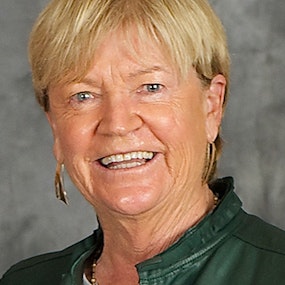
Blalock, Jane
Golf Professional
Jane Blalock is a former LPGA Tour champion who won 27 times and is perhaps best known for her record 299 consecutive tournaments played without missing a cut.
Today, Blalock is involved with two significant golf properties that have had a huge impact on advancing women in the game for the past two decades: the Women's PGA Clinics and Legends of the LPGA, Official Senior Tour of the LPGA.
Golf champion. Business guru. Activist trailblazer. Jane Blalock has racked up a lifetime of achievements that few others can claim.
Blalock joined the LPGA Tour in 1969 and remains one of its winningest players in history with 27 titles. A record-holder across all professional men’s and women’s golf tours, playing 299 consecutive tournaments without missing a cut, she retired from the tour in 1985 but not the sport, and has continued to have an indelible impact.
She founded JBC Golf, Inc. in 1990. This Boston-based golf and event marketing firm creates golf sponsorships and marketing opportunities for Fortune 500 companies and major corporations, consistently delivering goal-driven results. In 2001, Blalock spearheaded the Women’s Senior Golf Tour – now known as Legends of the LPGA, official senior tour of the LPGA – a coup for women of professional golf age 45 and over, creating opportunities for continued competitive golf in career afterlife.
Blalock also created and now heads up Women's PGA Clinics, a 30-year program that brings advanced instruction to the growing number of women who’ve developed a love of the sport for business and pl…
Read More
New to FORE the Good of the Game?
Here are some great episodes to start with. Or, check out episodes by topic.















